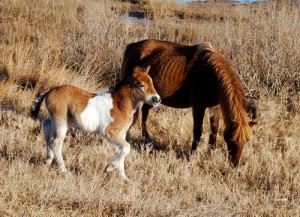
ASSATEAGUE — The new foal birthed on Assateague in December is thriving during her first month of existence on the barrier island, despite the brutal cold temperatures last week and the constant winter struggle for food, according to Assateague Island National Seashore officials.
The foal, known for now only by its alpha-numeric name N2BHS-AL, will turn one month old on Saturday, and despite a rather harsh winter welcome into life on Assateague, the young horse appears to be thriving thus far, despite some concerns raised in the community about her health and the health of her dam, known as N2BHS-A, or “Gokey Go Bones.”
Assateague Island National Seashore Science Communicator Kelly Taylor said this week the foal is thriving, despite the sub-zero temperatures for much of last week and what on the surface appears to be scarce grazing opportunities.
“She is doing great,” she said. “She’s doing everything a one-month old foal can be doing and should be doing. She looks great and has a good, fluffy winter coat. The dam is also in great shape.”
Taylor said the foal is nursing with her mother, who from recent pictures appears rather gaunt, but that is not unusual considering what she has been through recently with birthing a foal and the typical tribulations of a winter on the barrier island, according to Taylor.
“Mom is in great shape considering she just had a baby,” said Taylor. “Her coat looks good and she is healthy and doing well. She has to graze a lot because she is feeding the foal, and she has to work twice as hard to get the nourishment she needs because the food source is naturally not quite as abundant this time of year, but there is no reason to expect the foal and the dam are not healthy and thriving.”
It’s important to note that the famed herd of horses on Assateague are wild animals and are left largely to survive on their own. National Parks Service officials do monitor their whereabouts and their overall health to some degree, but do not feed them or provide shelter or medical care. Nonetheless, the herd is a hearty bunch and has adjusted over the generations to life on the windswept island. Thus far, the foal and the dam and the rest of the band are adjusting well to the new addition, Taylor maintained.
“We’ve been commenting lately on just how great a mother she is being,” said Taylor. “She is nursing and is very protective of the foal and never lets her stray too far from her sight. The rest of the band appears to be adjusting well also.”
In the 1970s, the National Park Service began naming new foals in the Assateague herd with an alpha-numeric code to help track the lineage of the wild horses and identify to which sub-herd they belong and the areas they frequent on the island. The new foal was birthed by NSBHS-A, or Gokey Go Bones, and although Gokey was often seen with NSBHSX, or Jester, when she became pregnant, the foal’s coloring suggests the sire is likely N9BM-E, or Yankee.
The new foal brings the size of the herd to 101, which is just about at the target range of 80 to 100. With just two foals birthed this year, the number came in lower than the statistical average. While three to five foals are birthed in a typical year, an in-kind number drop off due to old age, illness or other natural or man-made factors. The mortality rate is around three to five percent, meaning three to five out of 100 are lost each year to attrition, which coincides with the three to five new foals birthed in a typical year.
In the interest of managing the size of the herd, which, if left unchecked would overtake the barrier island and gobble up the very resources the wild ponies need to survive, the National Park Service several years ago began a contraceptive program for the mares in the herd. The mares are injected with a non-invasive contraceptive to prevent multiple births in an effort to maintain and ultimately shrink the size of the herd to its manageable threshold. In the interest of maintaining the gene pool of the famous wild ponies, believed to be descendants of domesticated horses placed on the island 300 years ago, each mare is allowed to birth one foal before being put on the contraceptive program.
